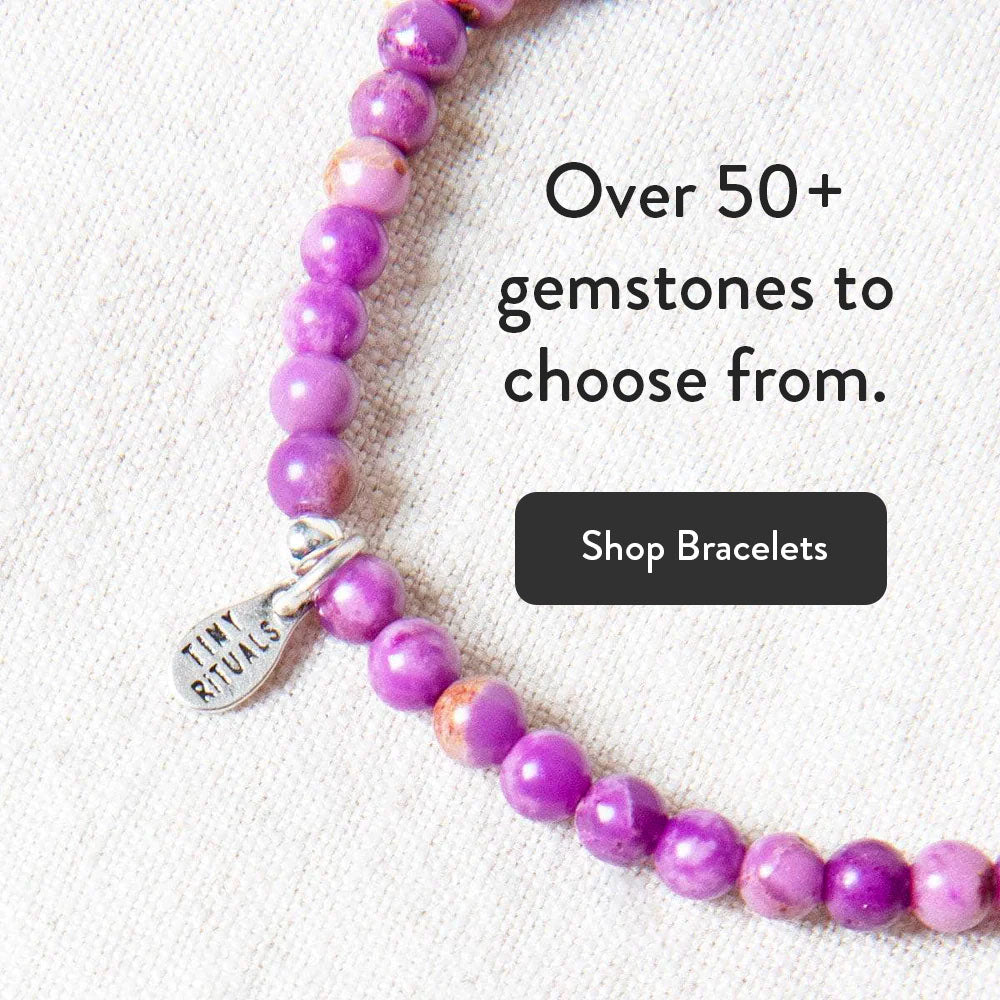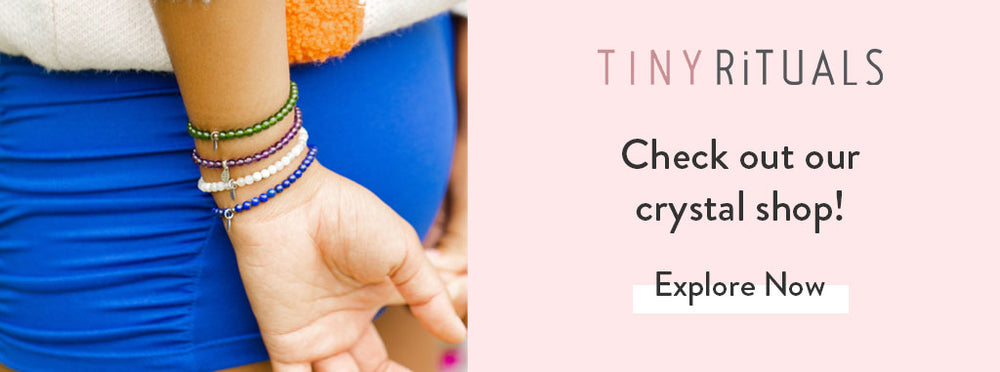
From warming red tones to bold Dalmatian spots, Jasper comes in an evocative array of colors and is splashed with intricate patterns - but all share the earthly delight of easy healing. Jasper is one of the most popular gemstones. It is known for its vibrancy and rich variety. Jasper is a microcrystalline variety of quartz and is often characterized by its earthy tones, opaque appearance, and unique mineral impurities, giving it color and charm.
As a hugely diverse stone, Jasper is significant across a variety of cultures and is a popular choice for jewelry and for those who want to invoke its metaphysical properties. Jasper was loved by the Ancient Egyptians who believed this stone was an amulet against negative energy and spiritual harm. In some aspects of Native American culture, it was believed Jasper could bring the rain and help with spiritual grounding. As you can see, Jasper's world is vast and beautiful. We look at the different types of Jasper and explore their unique properties and various uses.
Understanding Jasper
Composition and Formation: Jasper has elements and chemical compositions similar to quartz. It is created from silicon dioxide and various impurities, including iron oxides, clay, and organic materials. These various impurities give different kinds of Jasper intricate patterns and unique shades. Jasper is born of the earth—in places where heat, sedimentary rock, and volcanic ash meet. Time, heat, and various minerals running through hydrothermal veins lead to the formation of Jasper's dense, opaque microcrystalline structure.
Physical Properties: Jasper is a relatively durable stone, scoring a 6.5-7 on the Mohs hardness scale. This durable strength, blended with its variants of color and patterns, makes it a solid stone for jewelry and crystal decor. It can be cut and polished in various forms. The fact that Jasper is available across the world - from Brazil, India, Madagascar, Russia, Australia, and the United States- makes it a gemstone that can be chosen in abundance.
Main Types of Jasper

Red Jasper
Description: As the name suggests, Red Jasper is a deep red color with warm hues. It is often streaked or with spots. The bright red shades come from the inclusion of iron.
Origin: One of the more popular types of Jasper, Red Jasper crystals can be sourced worldwide with large sources in countries like the United States, Brazil, and Australia.
Properties: Red Jasper is known for its glorious grounding properties and for stabilizing the aura. The meaning of Red Jasper can enhance physical strength and prowess, boost confidence, and bring emotional balance. It is also believed to protect against negative elements.
Ocean Jasper
Description: With its orbicular pattern and vibrant bands of color, Ocean Jasper takes its name from its shades and patterns that represent an underwater scene.
Origin: Ocean Jasper is only found on the sweet vanilla shores of Madagascar, making it a highly sought-after and rare gemstone.
Properties: With its ocean flow, Ocean Jasper is believed to elevate the spirit and bring joy to all who encounter it. Wearing an Ocean Jasper Bracelet can also help you to release tough emotions and negative states of mind.
Yellow Jasper
Description: As the name suggests, Yellow Jasper comes in shades that range from bright sunshine to deep mustard. This stone is often mottled or banded, and its coloring comes from the presence of iron and other impurities.
Origin: Yellow Jasper is commonly found in South Africa and India and is extensively mined, making it a relatively easy stone to obtain.
Properties: Yellow Jasper is a journey stone, which means it is a glorious amulet for traveling or embarking on a spiritual journey. It has protective qualities but also boosts confidence and clarity of mind as it works with the sacral and solar plexus chakras.

Leopard Skin Jasper
Description: Leopard Skin Jasper is named for its orbicular patterns, which closely resemble leopard spots. This style of Jasper has striking aesthetics, and the color of the stone itself can vary.
Origin: Leopard Skin Jasper is predominantly found in Mexico. Thanks to its visual charm, this stone is very popular for use in jewelry or decorative items.
Properties: Leopard Skin Jasper is considered a shamanic stone that can even be used to connect with animal spirits. It is said to enhance shamanic journeying and have great spiritual prowess. Wearing a Leopard Skin Jasper Bracelet is also geared towards personal growth and transformation.
Green Jasper
Description: Green Jasper ranges from pale green to dark olive and is typically opaque. Its serene green hues come from the presence of iron silicates.
Origin: Green Jasper tends to be mined in Egypt and India. This is a version of Jasper that has been valued for centuries.
Properties: Being a green crystal, this type of Jasper connects to the heart chakra. Green Jasper is known for balancing obsessive tendencies and bringing harmony into all corners of your life. Green Jasper can be a joy for those needing emotional healing.
This is just a small sample of some of the most intriguing and popular kinds of Jasper, but there is such a wide range of Jasper out there that you are sure to find the one that suits your style. Here are some other famed names in the Jasper world - Rainbow Jasper, Poppy Jasper, Black Jasper, Picasso Jasper, Imperial Jasper, Brown Jasper, Blue Jasper, Dalmatian Jasper, Owyhee Jasper, Bruneau Jasper, Honey Jasper, Crocodile Jasper, Kona Jasper, Mariam Jasper, Elephant Skin Jasper, and Royal Plume Jasper. As you can see, the world of Jasper gemstones includes vibrant colors, banded patterns, and unique properties.
Rare and Unusual Types of Jasper

Check out our Mookaite Jasper Bracelet
Kambaba Jasper: Kambaba Jasper is a dark green jasper with fossilized algae. It's known for its unique and intricate patterns, and one glance at this stone can transport you back to prehistoric times. This stone is found in Madagascar and South Africa, and due to its ancient roots, it is considered a highly prized jasper by collectors. With its intense grounding properties, Kambaba Jasper is believed to reduce fearful thinking and give you a great big boost of confidence.
Bumblebee Jasper: Bumblebee Jasper takes its name for being a bright yellow banded jasper with black stripes. It has volcanic origins, and the colors of jasper here are the result of mineral inclusions such as sulfur, hematite, and even arsenic. Because of arsenic, it should be handled with care and not worn for prolonged periods against the skin. It should not be ingested in any form and is often coated and sealed to protect the wearer. Bumblebee Jasper is connected to creative thinking and personal growth.
Mookaite Jasper: Mookaite Jasper is famed for its rich colors and patterns - from bold reds to bright yellow colors and purples. This striking mash-up of shades makes it visually very alluring. It is exclusively found in Western Australia, particularly in the Mooka Creek region, from which it derives its name. This also means it is a highly sought-after stone by collectors and those who want to use its intricate color schemes in jewelry like Mookaite Jasper Bracelets and decorative items. Mookaite Jasper is also used in anti-aging treatments and is known for its rich rejuvenating properties.
Jasper in Modern Times

Current Applications: Jasper is considered an excellent stone for decorative objects and jewelry in the modern world. Its unique patterns and range of colors give it an enticing look in bracelets, necklaces, rings, and earrings and its healing properties also add to the appeal. Jasper is considered a very earthy stone with huge nurturing energy. It can work with confidence, grounding, and a sense of safety and elevate your focus and strength. Different types of Jasper also bring their own healing properties, which is why all the varieties mean you can pick a Jasper that aligns with your own positive energies, intentions, or needs.
Collecting Jasper: Those who want to add true Jaspers to their crystal collection can follow a few easy tips to ensure they pick the real deal. True Jaspers will have rich earthy tones and often have inclusions and distinctive patterns that range from black spots to swirls and banded color schemes. Authentic Jaspers are also quite hard and range from 6.5 to 7 on the Mohs hardness scale. It should be scratch resistant. Jasper also tends to be an opaque stone, so if you are holding a transparent gem, this may not be a Jasper but a different type of quartz. Jasper will often have natural inclusions, so avoid gemstones that look too perfect.
Caring for Jasper: Keep your Jasper stone cleansed and charged to ensure it works to the best of its ability. Regular cleansing is important not just for the physical appearance of the stone but for the physical energy, too. Crystals work hard to soak up negative vibes, so it's important to discharge them from time to time and recharge them with fresh energy to keep their vibrations high. You can do this through several methods, including placing them in moonlight, smudging with your favorite herb, using sound baths and tuning forks, burying them in soil, or placing them in a crystal bowl made of Selenite or Clear Quartz from your local crystal shop.
Conclusion
Jasper is a gorgeous gemstone that comes in a diverse variety of colors, with unique patterns, styles, and its own personal power. Few crystals in the world span so far and capture such a range of colors than Jasper. Its birth from volcanic activity gives it a rare earth power, and with so many popular varieties to choose from, you will truly be spoilt for choice. Experiment with different forms of jasper and find the gemstone that suits your mood.
FAQs
Are there different types of jasper
There are many types of Jasper, from popular varieties like Red Jasper to rare types like Bumblebee Jasper. Many types of Jasper get their names from the area where they are found or from the coloring of the gemstone.
What color jasper is rarest
Blue Jasper is the rarest color. Although there are many varieties of Jasper, from red to green, Yellow, and in a range of shades and patterns, Blue Jasper is considered quite rare.
How many shades of jasper are there
You get many shades of Jasper ranging from red to green to blue and yellow - even brown and purple and some stones have multiple colors in one pretty piece. The coloring of the Jasper can be due to the mineral impurities and iron content.
How to tell if jasper is real
Natural Jasper will be a relatively hard and durable stone, scoring a 6.5-7 on the Mohs hardness scale. It is also an opaque stone with natural inclusions. These are the things you want to look for when deciding if your Jasper is authentic.













